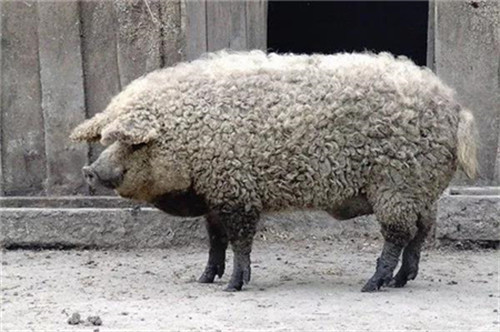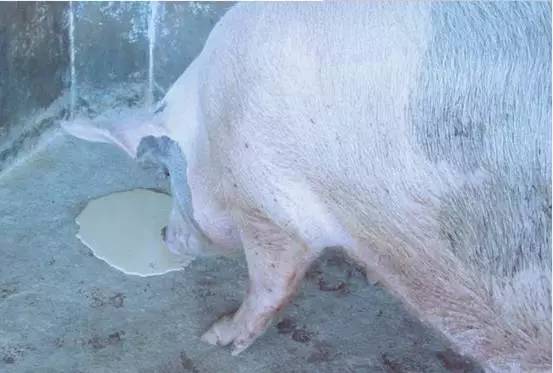Analysis of the key work of postpartum sows and the prevention and treatment of abnormal conditions.
Sows should observe food intake and body temperature changes at any time after delivery, and pay attention to massive hemorrhage, postpartum mastitis, paralysis, postpartum lack of milk and so on. The birth canal of artificial midwifery sows should be cleaned and drugs should be taken to reduce inflammation. Gradually increase the feed 2-5 days after delivery, reach the highest dosage after 1 week, and give as much as you can. Reached 2.5 ┧ + 0.5x ┧ (G is daily feed ┧, X is the number of piglets brought by sows). 2-3 days before weaning, diet should be reduced according to the fat condition of sows, and drinking water should be controlled.
Check the placenta.
Check whether the placenta is completely excreted, and whether the number of placenta or umbilical cord is consistent with the litter size. If the placenta does not fall, 10 mg diethylstilbestrol is injected intramuscularly. After cervical dilatation, oxytocin 30 international units can be injected intramuscularly every 30 minutes for 2 or 3 consecutive times. After confirming that the placenta was completely excreted, 80 ~ 1.6 million international units of penicillin were injected into the deep part of the birth canal.
Adopt appropriate anti-inflammatory methods
Parturient sows or fetuses are too large or too many, dystocia sows are prone to uterine damage, anti-inflammation for 7 days as a course of treatment, each dose of penicillin per kg body weight intramuscular injection of 30,000 units, twice a day. At the same time, 0.1% potassium permanganate solution at a temperature of 0.1% can be injected into the birth canal until it returns to normal. For sows with a history of postpartum illness, the medicine is also given according to the above method.
For normal parturient sows, each dose of penicillin per kilogram of body weight was 20,000 units, twice a day for 20 days.
After anti-inflammatory sows, there is still purulent discharge from the birth canal 1 week later:
First, the uterus was infused with lukewarm 0.1% potassium permanganate solution 200g 300ml, while 5 mg of diethylstilbestrol was injected intramuscularly to dilate the cervix, and oxytocin 30 international units was injected intramuscularly in about 30 minutes, once every 30 minutes, twice in a row. At the same time, the mixture of green and streptomycin was injected intramuscularly, combined with dexamethasone phosphate injection. The mixture of 10% glucose saline + penicillin 80 ~ 1.6 million units can also be put into the deep part of the birth canal, once a day for 3 consecutive days, with excellent results.
For sow postpartum anti-inflammation, removing blood stasis and removing stagnation, the placenta can also be fed with Chinese herbal medicine. Boil the fresh motherwort 0.25kg + water 1000 ml to 300kg 400ml, add 0.2kg brown sugar after cooling, mix and feed it in the morning and evening for 3 consecutive days, the effect is better.
Feeding aspect
During childbirth, there is a lot of physical exertion and a lot of body fluid loss, and the sows show fatigue and thirst, so prepare enough, warm 1% salt water for the sows to drink. Sows should not be fed within 8 hours after parturition, warm water should be supplied, and liquid food should be given in the morning the next day, because the digestive function of postpartum sows is very weak, so the feeding quantity should be restored gradually. If the digestibility of the sow recovers well and there are more piglets; it can be restored to the pre-parturition feeding amount after 2 days, and if the sow has less milk or no milk, measures must be taken immediately to save the piglets, and some porridge feeds for lactation can be prepared first, such as Millet Congee, soup made with small fish and shrimp, soy milk, milk, etc., fed three times a day, and then gradually decreased until the milk stopped. If it still doesn't work, you can use medicine to promote lactation.
Prolactin:
Wang Buliuxing 40 grams, Aristolochia mandshurica 30 grams, motherwort 50 grams, Liushenqu 40 grams, Jingsan 30 grams, red peony 20 grams, fried malt 50 grams, du safflower 30 grams, 8 herbs mixed with boiled juice, 1 dose a day, twice a day, 2 Ling for 3 days.

Management aspect
After the sows give birth, the contaminants should be removed in time. After the walls, floors and railings are cleaned, 2% Laisuer is sprayed for disinfection, so as to create a hygienic, quiet and fresh air environment for the sows. Carefully observe the dynamics of sows and piglets after delivery. There are varying degrees of damage to the uterus and birth canal of sows after delivery, and the pathogenic microorganisms are easy to invade and reproduce, which brings harm to the body. For common diseases such as uterine inflammation, postpartum fever, mastitis, piglet dysentery and other diseases should be detected and treated as early as possible, so as not to infect the whole litter of piglets.
For example, if a sow is found to be in low spirits, loss of appetite, leftovers and other phenomena, it is necessary to find out the cause in time. If it is caused by uterine inflammation, it can be cured after continuous injection of penicillin for 2 days, which generally will not affect the lactation of piglets. If piglets are found to have diarrhea, the source of infection should be cleared immediately and treated in time. After 3 days of delivery, sows can be put into the playground for free activities, so that they can come into contact with the sun, restore physical strength and promote digestion, which is very beneficial to improve milk production. But the activity time should not be too long to prevent cold and shock. In the investigation of sow production in this county, the author found that the majority of professional sow farmers in rural areas do not pay attention to hygienic measures for postpartum sows, which can easily cause many common obstetrical diseases in sows, such as postpartum hysteritis, mastitis, no milk syndrome, postpartum fever, tetanus, postpartum fasting and so on, so as to affect reproductive function and even be eliminated. Paying attention to the postpartum hygiene of sows can greatly reduce the occurrence of many postpartum diseases.
Prevention of common postpartum diseases in sows
1. Refuse to eat after delivery.
Sows refusing to eat due to birth canal infection can be injected intramuscularly with penicillin 8 million units and streptomycin 4 million units mixed in 20 ml analgin, twice a day for 2 days. For sows with anorexia caused by excessive feed and high feed concentration, the combination of concentrate, roughage and green fodder should be reasonable, and sows should not be fed too fat or too thin.
2. No milk and less milk after delivery
Take 10 tablets of prolactin for 3-5 days, or intramuscular injection of oxytocin 20-30 units, 1-2 times. Wash the placenta and stillborn babies, boil them with water and salt, and take them internally. Earthworms, river shrimp and small fish (especially crucian carp) all have the effect of lactation, which can be boiled and taken. Chinese medicine prescriptions can also be used: Angelica sinensis, Wang Bu Liuxing, Leaku, Tongcao 30 grams each, boiled, mixed with wheat bran to feed. Once a day for 3 days.
3. Postpartum constipation
The following methods can be used for prevention and control:
⑴ plus turquoise feed
⑵ increases drinking water and adds artificial rehydration salt
⑶ glucose saline 500-1000 ml, vitamin C 10 ml 3, one intravenous injection
⑷ compound vitamin B1-5 ml, penicillin 2.4 million units, antongding 30 ml, intramuscular injection respectively
40 tablets each of ⑸ yeast, rhubarb soda tablets, multi-enzyme tablets and lactase tablets, taking 4 times as fine powder
⑹ daily feed baking soda (sodium bicarbonate) 25 grams, divided into 2-3 times, drinking water.
4. Prolapse of uterus after delivery
When the uterus is not completely protruded, 0.1% potassium permanganate solution or normal saline 500-1000 ml can be injected into the uterine cavity to restore the uterus with the help of liquid pressure. For complete uterine prolapse, the feces attached to the mucous membrane should be removed and washed with 0.1% potassium permanganate solution or 1% salt water. For severe edema, wash with 3% alum water. During the reduction, 2 people held the uterus and vagina equal height, 1 person grasped the uterine horn with his left hand, and the right thumb was restored from the uterine horn. Then hold the hand into a cone like turning the intestines, push hard when the pig is not responsible, and turn in in turn. Using this method, the horns of the two uterus are pushed into the uterine body successively, and at the same time, the uterine body is pushed into the pelvis and abdominal cavity. After the restoration, the vulva was sutured with 2 stitches of thick silk thread to prevent prolapse. Be anesthetized if necessary. After reduction, antibiotics were injected to reduce inflammation.
5. Postpartum claudication of sows
Antibacterial and anti-inflammatory when there is trauma: use antongding 10 ml, penicillin 3.2 million units, vitamin B1-10 ml, twice a day, intramuscular injection; dexamethasone 10 ml, once a day; intravenous injection of 10% calcium gluconate 150,200ml, once a day for 6-10 days. If the pain is severe, 20% sodium salicylate 20 ml is added during intravenous injection, and the lumbar pain can be blocked with procaine.
6. Postpartum paralysis of sows
Dry and crush pig bones or other fresh livestock and poultry bones, mix them with feed and feed pigs, each with 30 grams a day. If the patient is seriously ill, use 5-10% calcium chloride injection 40-80 ml once intravenously. You can also use a high degree of liquor to smear the skin and carry out artificial massage to promote its blood circulation and restore nerve function. In addition, the content of wheat bran in the diet can be increased appropriately. For rice bran and other phosphorus-rich feed, adding sweet potato vine and other calcium-rich roughage, as much as possible to feed green feed, also has a good effect on the prevention of sow paralysis. (source: raising pigs today)
- Prev

Respiratory diseases occur frequently in pig farms. Have you carefully considered the reasons?
Respiratory diseases occur frequently in pig farms. Have you carefully considered the reasons?
- Next

When your pig vomits, what's the first thing you think of?
When your pig vomits, what's the first thing you think of?
Related
- On the eggshell is a badge full of pride. British Poultry Egg Market and Consumer observation
- British study: 72% of Britons are willing to buy native eggs raised by insects
- Guidelines for friendly egg production revised the increase of space in chicken sheds can not be forced to change feathers and lay eggs.
- Risk of delay in customs clearance Australia suspends lobster exports to China
- Pig semen-the Vector of virus Transmission (4)
- Pig semen-the Vector of virus Transmission (3)
- Five common causes of difficult control of classical swine fever in clinic and their countermeasures
- Foot-and-mouth disease is the most effective way to prevent it!
- PED is the number one killer of piglets and has to be guarded against in autumn and winter.
- What is "yellow fat pig"? Have you ever heard the pig collector talk about "yellow fat pig"?

